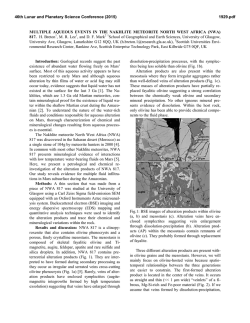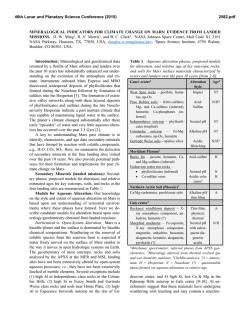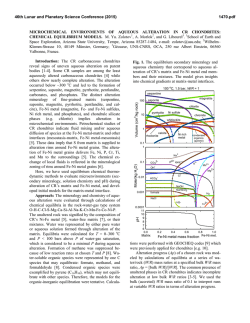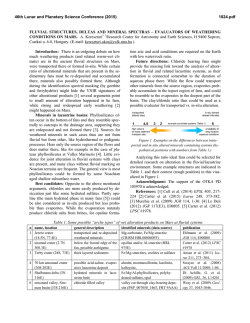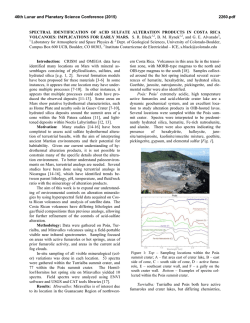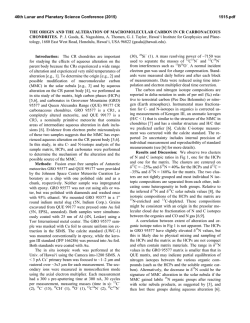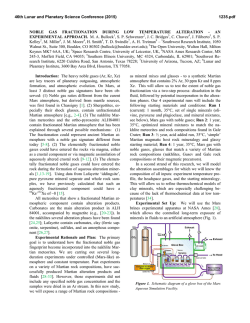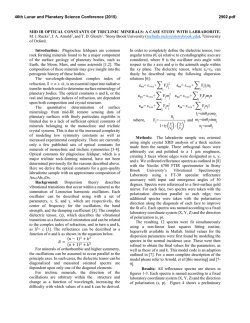
partitioning of iron and trace metals during isochemical
46th Lunar and Planetary Science Conference (2015) 2903.pdf PARTITIONING OF IRON AND TRACE METALS DURING ISOCHEMICAL HYDROTHERMAL BASALT ALTERATION: IMPLICATIONS FOR INTERPRETING CLAY OCCURRENCE ON MARS. R. D. Nickerson1, S. M. Chemtob1, and J. G. Catalano1, 1Washington University, Dept. of Earth and Planetary Sciences, St. Louis, MO 63130 ([email protected]). Introduction: Orbital spectroscopic observations of the Martian surface show global detections of minerals associated with past aqueous alteration [1,2]. These detections of secondary minerals occur in a diverse set of environments and likely occur due to a variety of mechanisms. A significant fraction of detections show evidence of having originally formed in the subsurface as part of hydrothermal systems [3,4]. Alteration in these hydrothermal settings may have been isochemical [5,6]. Thermodynamic models predict that isochemical alteration of basaltic crust in low-O2 conditions results in the formation of Fe2+ and Mg bearing trioctahedral smectites [7,8,9]. Recent observations of smectite-bearing units at Endeavor Crater by MER Opportunity suggested trace element repartitioning in some units [10]. Terrestrial studies of aqueous alteration of oceanic crust show substantial mobilization of trace metals [11]. It has been shown that the ultimate fate of mobilized elements is strongly affected by formation of secondary minerals such as phyllosilicates [12]. Trace element data may thus yield information on the degree and character of rock alteration to phyllosilicates on Mars. As iron is highly redox active, its speciation in altered materials can provide further information on the nature of altering fluids on early Mars. Additionally, a general understanding of the process of elemental repartitioning may allow us to make predictions for areas where observational data is limited. Methods: This study investigates the alteration of whole-rock assemblages under isochemical hydrothermal conditions. Two mafic USGS rock standards were selected for their chemical similarity to basalts studied at Gusev Crater [13] (BIR-1a, Icelandic basalt; DNC1a, North Carolina dolerite). In order to study iron and trace metal repartitioning during serpentinization, a dunite (DTS-2b, Twin Sisters dunite) was also used. All rock powders were ground in a micronizing mill to a uniform 1-5 μm particle size prior to alteration. All preparation occurred in an oxygen free environment. The samples were then sealed in PTFE-lined reaction vessels and heated at 200 oC for 21 days in an oxygen-free nitrogen atmosphere. After reaction excess fluid was decanted and samples were dried for analysis. Unground replicates were prepared for imaging analysis to more clearly investigate the spatial relationship of primary and secondary phases. Major mineralogy was investigated by spot analysis with a JEOL JXA-8200 electron microprobe (EPMA) and powder XRD on a Bruker D8 Advance diffractometer. Mineral abundances were quantified by Rietveld analysis using TOPAS. Trace metal and iron partitioning was studied by Xray absorption fine structure (XAFS) spectroscopy. Fe, Mn, Ni, and Zn K-edge spectra were collected on Advanced Photon Source beamlines 5-BM, 12-BM, and 13-BM for both unaltered and altered samples. Fe spectra were collected in transmission mode and trace metal spectra were collected in fluorescence mode. XAFS spectra provide information on oxidation state and local coordination environment (within ~5 Å) of the target atom. For a spectral standard, ferrous trioctahedral smectite doped with 1 mol% each of Mn, Zn, and Ni and matching the major element composition of an alteration rind measured by EPMA was synthesized [14]. Elemental mapping was done on epoxy mounted slides by both electron microprobe and X-ray microprobe (APS beamline 20-ID). Imaging was performed on a JEOL 7001LVF SEM. Results: The unaltered basalt standards, BIR and DNC have similar chemical compositions but differ in their relative mineral abundances. They contain similar amounts of forsterite (12.7 wt% and 15.1 wt% respectively) but differ in amounts of plagioclase and pyroxene (plag: 47.6 wt% and 60.0 wt%; pyx: 36.9 wt% and 20.3 wt%). The BIR also has more opaques than the DNC though these are minor phases in both rocks. DNC contains minor chlorite while secondary mineralization is not detectable in BIR by XRD. DTS is dominantly forsterite (91.3 wt%) with minor chlorite, diopside and lizardite (all 2-3.5 wt%). In all unaltered samples, XAFS spectroscopy shows that Fe is primarily located in olivine. This is especially pronounced in DTS where the Fe spectrum is nearly identical to that of pure olivine. Altered samples all contain neoformed phyllosilicates (Figure 1). BIR and DNC produced a trioctahedral smectite clay, with greater alteration seen for DNC. In the DTS experiment, 22% of the forsterite reacted to roughly equal parts serpentine and brucite by weight. XAFS spectroscopy shows that Fe is liberated from olivine upon alteration and is taken up by secondary minerals. BIR and DNC have Fe XAFS spectra which resemble that of a synthetic trioctahedral Fe-Mg 46th Lunar and Planetary Science Conference (2015) smectite and have 15.2-15.8 Å basal reflections in XRD [14]. (Figure 2) The XAFS spectra of DTS indicates that partial Fe oxidation occurs during alteration. Magnetite was not detectable produced it is unclear what phase hosts the oxidized Fe. DTS has the lowest total amount of iron of any of the rock standards so it's possible that a small amount of magnetite produced could have a disproportionately large effect on the Fe XAFS while being difficult to distinguish from chromite in XRD. Mn appears to follow Fe during alteration in most samples. (Figure 3) Before alteration, the Mn XAFS spectra of all samples are nearly identical to that of pure olivine. Spectra of the altered samples are very similar to that of Mn in the doped trioctahedral smectite standard. The changes in the Mn XAFS spectra in the altered samples are proportional to the relative degree of alteration, with the spectrum of BIR changing the least and of DTS changing the most. Ni also appears to follow Fe during alteration but the XAFS spectra for BIR and DNC suffer from high noise levels, making quantitative comparison to the Mn data difficult. In DTS Ni is originally located in olivine and upon alteration is repartitioned into a new phase. In contrast to Mn and Ni, Zn experiences no change in its XAFS spectra upon alteration. Zn is primarily housed in refractory oxide minerals and not mobilized during hydrothermal alteration. These results show that even small changes in mineralogy produce large differences in the character of alteration. Additionally comparing mobile and immobile trace metals shows promise for being an additional marker for degree of alteration. These studies predict that hydrothermally altered basalts on Mars should show Mn and Ni repartitioning behavior distinct from that of Zn. References: [1] Murchie et al., (2009) JGR, 114, E00D06. [2] Carter et al., (2013) JGR:Planets, 118, 831-858. [3] Ehlmann et al. (2011) Nature, 479, 53-60. [4] Ehlmann et al. (2011) Clays and Clay Min., 59, 4, 359-377. [5] Franzson, Zierenberg, and Schiffman (2008) J. Volcanol. Geotherm. Res., 173, 217229. [6] Cann and Vine (1966) Phill. Trans. R. Soc. Lond., 259, 198-217. [7] Marion, Catling, and Kargel, (2003) Geochim. et Cosmochim. Acta, 67, 22, 42514266. [8] Ehlmann et al., (2012) JGR, 117, E00J16. [9] Catalano (2013) JGR, 118, 2124-2136. [10] Arvidson et al., (2014) Science, 343, 6169, 1248097. [11] Humphris and Thompson, (1978) Geochim. et Cosmochim. Acta, 42, 127-136. [12] Manceau et al., (2002) Rev. in Mineralogy and Geochem., 49, 1, 341428. [13] McSween et al. (2004) Science, 305, 842845. [14] Chemtob et al., (2014) LPS XXXXV, Abstract #1193. 2903.pdf Figure 1. Smectite rind growing on an olivine crystal. Figure 2. Mn XAFS of selected altered and unaltered samples compared to standards. Figure 3. Mn XAFS of altered and unaltered samples compared to standards.
© Copyright 2025

